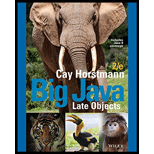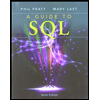
Concept explainers
Given Program:
The program given in the textbook is given here with comments for better understanding.
File Name: TaxReturn.java
// Class definition
public class TaxReturn
{
// Declare and initialize the required variables
public static final int SINGLE = 1;
public static final int MARRIED = 2;
private static final double RATE1 = 0.10;
private static final double RATE2 = 0.25;
private static final double RATE1_SINGLE_LIMIT = 32000;
private static final double RATE1_MARRIED_LIMIT = 64000;
private double income;
private int status;
/*Constructs a TaxReturn object for a given income and marital status.
@param anIncome the taxpayer income
@param aStatus either SINGLE or MARRIED */
// Method definition
public TaxReturn(double anIncome, int aStatus)
{
income = anIncome;
status = aStatus;
}
// Method definition
public double getTax()
{
// Declare and initialize the required variables
double tax1 = 0;
double tax2 = 0;
/* If the entered status is "Single", compute income tax based on their income */
if (status == SINGLE)
{
/* Check whether the income is less than or equal to $32000 */
if (income <= RATE1_SINGLE_LIMIT)
{
// If it is, compute the tax
tax1 = RATE1 * income;
}
/* If the income is greater than or equal to $32000, compute the tax */
else
{
tax1 = RATE1 * RATE1_SINGLE_LIMIT;
tax2 = RATE2 * (income - RATE1_SINGLE_LIMIT);
}
}
/* If the entered status is "Married", compute income tax based on their income */
else
{
/* Check whether the income is less than or equal to $64000 */
if (income <= RATE1_MARRIED_LIMIT)
{
// If it is, compute the tax
tax1 = RATE1 * income;
}
/* If the income is greater than or equal to $64000, compute the tax */
else
{
tax1 = RATE1 * RATE1_MARRIED_LIMIT;
tax2 = RATE2 * (income - RATE1_MARRIED_LIMIT);
}
}
// Return the tax to the main function
return tax1 + tax2;
}
}
File Name: TaxCalculator.java
// Import the required package
import java.util.Scanner;
/**
This program calculates a simple tax return.
*/
// Class definition
public class TaxCalculator
{
// Main class declaration
public static void main(String[] args)
{
// Create an object for scanner class
Scanner in = new Scanner(System.in);
// Prompt the user to enter the income
System.out.print("Please enter your income: ");
// Store the entered income in the variable
double income = in.nextDouble();
// Prompt the user to enter marital status
System.out.print("Are you married? (Y/N) ");
// Store the entered value in a variable
String input = in.next();
// Declare the variable
int status;
/* Check whether the user input value for marital status is "Y" */
if (input.equals("Y"))
{
/* If it is "Y", store the taxreturn value for a married person in the variable */
status = TaxReturn.MARRIED;
}
/* Check whether the user input value for marital status is "N" */
else
{
/* If it is "N", store the taxreturn value for a single person in the variable */
status = TaxReturn.SINGLE;
}
// Create an object for TaxReturn class
TaxReturn aTaxReturn = new TaxReturn(income, status);
// Display the tax return value based on the user input
System.out.println("Tax: "
+ aTaxReturn.getTax());
}
}
Want to see the full answer?
Check out a sample textbook solution
Chapter 3 Solutions
Big Java Late Objects
- What IETF protocol is NetFlow associated with? Group of answer choices IPX/SPX IPIX HTTPS SSHarrow_forwardHow can I perform Laplace Transformation when using integration based on this?arrow_forwardWrite an example of a personal reflection of your course. - What you liked about the course. - What you didn’t like about the course. - Suggestions for improvement. Course: Information and Decision Sciences (IDS) The Reflection Paper should be 1 or 2 pages in length.arrow_forward
- using r languagearrow_forwardI need help in explaining how I can demonstrate how the Laplace & Inverse transformations behaves in MATLAB transformation (ex: LIke in graph or something else)arrow_forwardYou have made the Web solution with Node.js. please let me know what problems and benefits I would experience while making the Web solution here, as compared to any other Web solution you have developed in the past. what problems and benefits/things to keep in mind as someone just learningarrow_forward
- PHP is the server-side scripting language. MySQL is used with PHP to store all the data. EXPLAIN in details how to install and run the PHP/MySQL on your computer. List the issues and challenges I may encounter while making this set-up? why I asked: I currently have issues logging into http://localhost/phpmyadmin/ and I tried using the command prompt in administrator to reset the password but I got the error LOCALHOST PORT not found.arrow_forwardHTML defines content, CSS defines layout, and JavaScript adds logic to the website on the client side. EXPLAIN IN DETAIL USING an example.arrow_forwardusing r languangearrow_forward
- Np Ms Office 365/Excel 2016 I NtermedComputer ScienceISBN:9781337508841Author:CareyPublisher:Cengage
 Operations Research : Applications and AlgorithmsComputer ScienceISBN:9780534380588Author:Wayne L. WinstonPublisher:Brooks ColeCOMPREHENSIVE MICROSOFT OFFICE 365 EXCEComputer ScienceISBN:9780357392676Author:FREUND, StevenPublisher:CENGAGE L
Operations Research : Applications and AlgorithmsComputer ScienceISBN:9780534380588Author:Wayne L. WinstonPublisher:Brooks ColeCOMPREHENSIVE MICROSOFT OFFICE 365 EXCEComputer ScienceISBN:9780357392676Author:FREUND, StevenPublisher:CENGAGE L  C++ for Engineers and ScientistsComputer ScienceISBN:9781133187844Author:Bronson, Gary J.Publisher:Course Technology Ptr
C++ for Engineers and ScientistsComputer ScienceISBN:9781133187844Author:Bronson, Gary J.Publisher:Course Technology Ptr A Guide to SQLComputer ScienceISBN:9781111527273Author:Philip J. PrattPublisher:Course Technology Ptr
A Guide to SQLComputer ScienceISBN:9781111527273Author:Philip J. PrattPublisher:Course Technology Ptr





